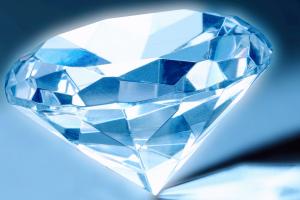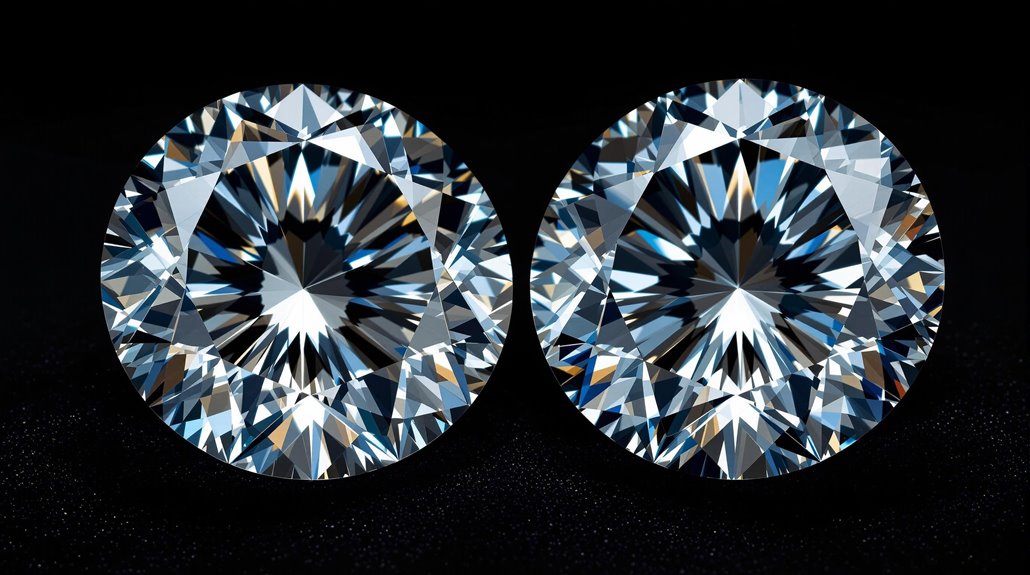Article Contents
- 1 Main Highlights
- 2 The Science Behind Diamond Formation
- 3 Ethical Implications of Diamond Choices
- 4 Price Points and Market Value
- 5 Certification and Quality Standards
- 6 Environmental Impact of Diamond Sources
- 7 Frequently Asked Questions
- 7.1 Can Lab-Grown Diamonds Change Colour or Deteriorate Over Time?
- 7.2 Do Insurance Companies Treat Lab-Grown Diamonds Differently from Natural Diamonds?
- 7.3 Are Lab-Grown Diamonds More Likely to Break During Jewellery Repairs?
- 7.4 Can a Jeweller Tell if a Diamond Is Lab-Grown Without Specialised Equipment?
- 7.5 Do Lab-Grown Diamonds Look Different Under Ultraviolet Light?
- 8 Our Final Thoughts
When you're choosing between natural and lab-grown diamonds, you're weighing more than just price tags – you're considering centuries of tradition against modern innovation. Natural diamonds, formed over millions of years beneath the Earth's surface, command premium prices and better resale value, but they come with environmental and ethical concerns. Lab-grown diamonds, chemically identical to their mined counterparts, offer significant savings and ethical clarity, though they depreciate faster. Both alternatives sparkle with equal brilliance and hold GIA certification, yet they tell vastly different stories about human ingenuity and Earth's resources. Your perfect diamond awaits in the details of their divergent paths.
Main Highlights
- Lab-grown diamonds are chemically identical to natural diamonds but cost 30-50% less, offering significant savings for budget-conscious buyers.
- Natural diamonds retain value better over time, maintaining up to 50% of their worth, while lab-grown prices continue to decline.
- Traditional diamond mining causes extensive environmental damage, requiring 250 tonnes of earth to be moved and releasing 125 pounds of carbon per carat.
- Both natural and lab-grown diamonds receive identical certification standards and quality grades from reputable organisations like GIA.
- Ethical concerns persist in natural diamond mining, while lab-grown diamonds avoid issues with conflict stones and exploitative labour practices.
The Science Behind Diamond Formation
Even though many people admire diamonds for their brilliance, the science behind their creation reveals an extraordinary process of nature and human innovation.
Deep within Earth's mysterious depths, carbon atoms move under immense pressure and searing heat, gradually coming together in a perfect diamond crystallisation that spans millions of years. This transformation occurs 725,000 pounds per inch beneath Earth's surface, an astounding pressure that forces carbon into its crystalline form. Natural diamonds formed during this process date back 90 million to 3 billion years ago.
Yet today, you're witnessing a revolution in how these precious jewels come to be. Laboratory techniques have mastered nature's recipe, creating diamonds in mere weeks through sophisticated HPHT and CVD processes. These synthetic gems are virtually identical to mined diamonds, offering equivalent clarity grades at a fraction of the cost.
Whether formed in Earth's ancient crucible or born from modern science's precision, both paths lead to the same stunning result – pure carbon transformed into crystalline perfection.
You're living in an age where the strength to create nature's masterpiece lies within human hands.
Ethical Implications of Diamond Choices
When you're choosing a diamond, you're making more than just a style decision – you're casting a vote for ethical or problematic practices in the industry.
Like ripples in a pond, your choice resonates through complex global supply chains, touching countless lives along the way. Traditional mining's dark legacy of conflict diamonds and exploitative labour practices has long cast shadows over the industry's sparkle, as lab-grown substitutes present their own ethical considerations.
You'll need to navigate the murky waters of ethical sourcing, whether you're drawn to the Earth's natural gems or modern science's creations. The Kimberley Process provides essential certification to prevent conflict diamonds from entering legitimate markets. The development of lab-grown diamonds offers a more environmentally conscious alternative that eliminates mining concerns entirely.
Each path demands careful consideration – from examining certification standards to investigating labour conditions. Your diamond's origin story matters, and it's your right to demand transparency from those who'd shield these truths behind brilliant marketing facades.
Price Points and Market Value
Beyond the ethical considerations, your diamond's price tag reflects a complex interplay of market forces and origin stories.
You'll notice striking price trends: a lab-grown diamond costs about 30-50% less than its natural counterpart, shimmering with the same brilliance but carrying a lighter financial burden. A one-carat natural diamond commands £4,200, whereas its laboratory-born twin asks just £1,000.
Yet, when considering investment potential, natural diamonds whisper promises of tomorrow, retaining up to half their value over time. These gems take billions of years to form naturally in the Earth. Larger diamonds especially hold their value, as they are rarer in nature.
Lab-grown stones, in spite of their identical sparkle, fade in market worth like morning dew. They're tumbling faster now, with prices dropping 20% in 2023 alone.
Your choice becomes a performance between immediate savings and long-term value, each path glittering with its own possibilities.
Certification and Quality Standards
Every diamond's journey to market passes through rigorous certification, where industry giants like GIA and AGS assess its authenticity and quality.
Like starlight captured in crystal, each jewel narrates its own tale through the unbiased lens of certification bodies, revealing its true essence beneath sophisticated testing equipment. Multiple expert graders provide independent assessments to ensure complete objectivity.
The new sustainability standards now require both natural and laboratory-grown diamonds to meet comprehensive environmental criteria.
You'll find that certification brings essential peace of mind through:
- Advanced testing methods that reveal whether your diamond is natural or lab-grown
- Detailed grading accuracy that examines every facet and flaw
- Security features like holograms and micro-printing to prevent tampering
- Standardised evaluations of the legendary 4Cs: Cut, Colour, Clarity, and Carat
This thorough process ensures you're getting exactly what you pay for, whether you choose the ancient legacy of earth-grown diamonds or their modern lab-created counterparts.
Environmental Impact of Diamond Sources
Even though certification guarantees a diamond's quality and authenticity, the true cost of these precious stones extends far beyond their price tag. When you choose a traditionally mined diamond, you're inheriting an environmental legacy that's far from pristine. Despite claims of sustainable mining, each carat disrupts nearly 100 square feet of land and generates 5,798 pounds of mineral waste, forever altering nature's delicate balance. Moving approximately 250 tonnes of earth is required to extract just one carat of diamond from traditional mining operations. The mining process releases 125 pounds of carbon emissions for every carat produced.
| Impact Type | Traditional Mining | Ecological Restoration Time |
|---|---|---|
| Land | 100 sq ft/carat | 10+ years |
| Water | Toxic contamination | 5-7 years |
| Marine | Reef destruction | 2-10 years |
The aftermath ripples through ecosystems: drained lakes in Canada, poisoned rivers in Zimbabwe, and scarred terrains that persist long after mining ceases. Each diamond emerges from a complex web of environmental consequences, leaving behind a footprint that nature struggles to erase.
Frequently Asked Questions
Can Lab-Grown Diamonds Change Colour or Deteriorate Over Time?
You'll enjoy outstanding colour stability and synthetic durability with lab-grown diamonds. They won't change colour or deteriorate over time unless they have undergone specific treatments that can fade.
Do Insurance Companies Treat Lab-Grown Diamonds Differently from Natural Diamonds?
You'll find most insurance policies treat lab-grown diamonds similarly to natural ones, though valuations differ. You'll need proper certification and appraisals for either type to get thorough coverage.
Are Lab-Grown Diamonds More Likely to Break During Jewellery Repairs?
Like steel forged in different furnaces, lab-grown and natural diamonds share identical durability. You won't face additional repair challenges with lab-grown stones – they're just as tough during jewellery maintenance.
Can a Jeweller Tell if a Diamond Is Lab-Grown Without Specialised Equipment?
You can't depend solely on a jeweller's expertise for precise diamond identification. Without specialised equipment, they won't be able to determine if your diamond is lab-grown or natural.
Do Lab-Grown Diamonds Look Different Under Ultraviolet Light?
When you shine UV light on diamonds, you'll notice distinct differences. Lab-grown stones exhibit stronger ultraviolet fluorescence, with HPHT diamonds displaying cross patterns and CVD diamonds showing stripes, as the colour of the diamond changes significantly.
Our Final Thoughts
You'll find that diamonds, whether formed in Earth's depths or cultivated in labs, each tell their own compelling story. Whilst traditionalists might argue that natural stones carry irreplaceable heritage, you're now equipped to see beyond marketing myths. Consider how your choice sparkles not just with beauty, but with conscious awareness of ethics, environment, and value. Let your diamond's origins reflect your values, as brilliant as the jewel itself.

